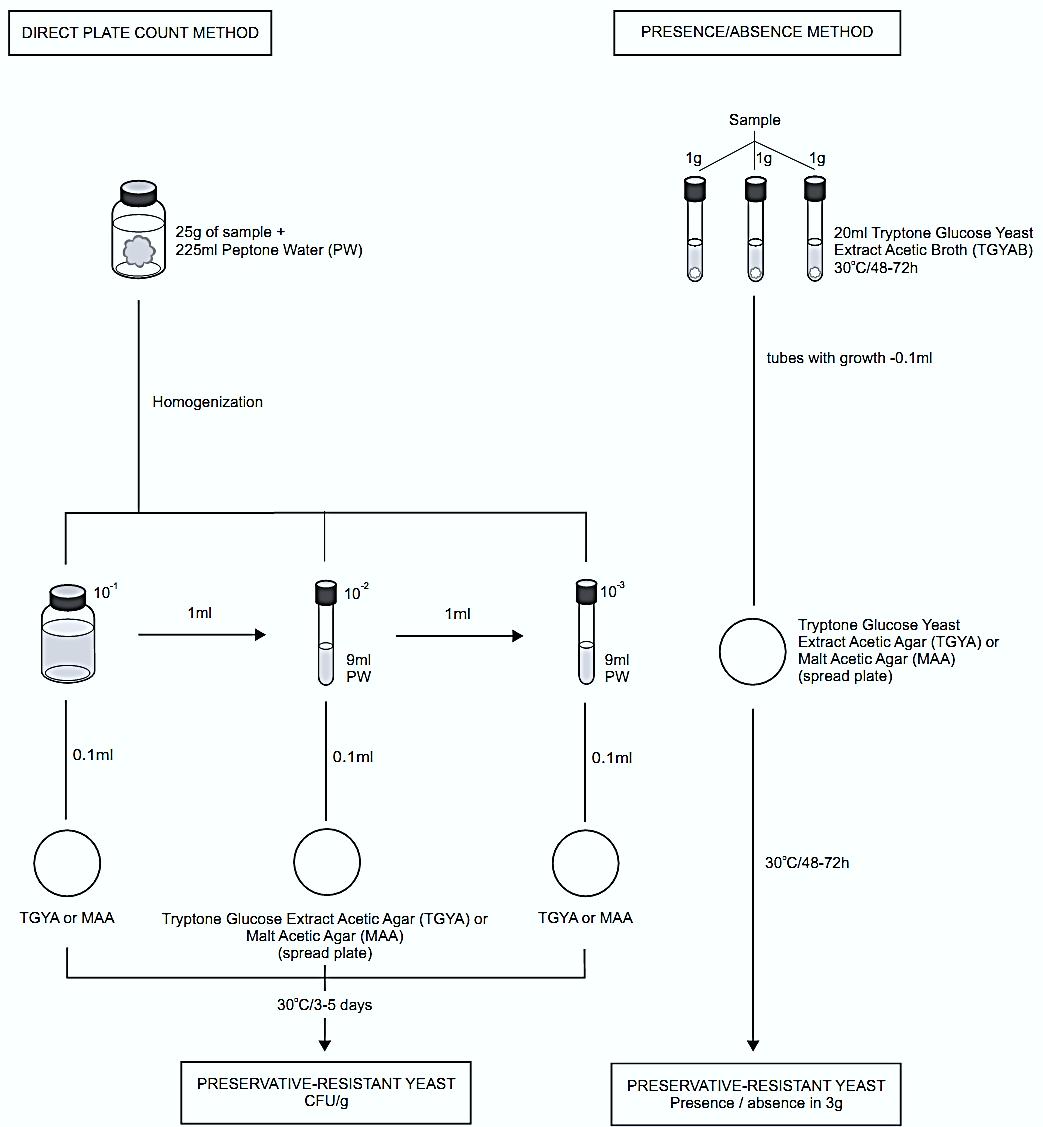
Presence/absence method Pitt and Hocking 2009 and Plate count method Pitt and Hocking 2009 for preservative-resistant yeasts in foods
 المؤلف:
SILVA, N.D .; TANIWAKI, M.H. ; JUNQUEIRA, V.C.A.; SILVEIRA, N.F.A. , NASCIMENTO , M.D.D. and GOMES ,R.A.R
المؤلف:
SILVA, N.D .; TANIWAKI, M.H. ; JUNQUEIRA, V.C.A.; SILVEIRA, N.F.A. , NASCIMENTO , M.D.D. and GOMES ,R.A.R
 المصدر:
MICROBIOLOGICAL EXAMINATION METHODS OF FOOD AND WATE A Laboratory Manual
المصدر:
MICROBIOLOGICAL EXAMINATION METHODS OF FOOD AND WATE A Laboratory Manual
 الجزء والصفحة:
الجزء والصفحة:
 22-3-2016
22-3-2016
 2368
2368
Presence/absence method Pitt and Hocking 2009 and Plate count method Pitt and Hocking 2009 for preservative-resistant yeasts in foods
Methods described in the 3rd Edition of the Fungi and Food Spoilage (Pitt and Hocking, 2009) and the 4th Edition of the Compendium of Methods for the Microbiological Examination of Foods (Beuchat and Cousin, 2001).
1- Material required for analysis
Presence/absence method
• Tryptone Glucose Yeast Extract Acetic Broth (TGYAB) (20 ml tubes)
• Tryptone Glucose Yeast Extract Acetic Agar (TGYA) (plates)
• Laboratory incubator set to 30±1°C
Direct plate count method
• Diluent: 0.1% Peptone Water (PW) or Butterfield’s Phosphate Buffer
• Dilution tubes containing 9 ml 0.1% Peptone Water (PW) or Butterfield’s Phosphate Buffer
• Tryptone Glucose Yeast Extract Acetic Agar (TGYA) or Malt Acetic Agar (MAA)
• Laboratory incubator set to 30±1°C
2- Procedure
A general flowchart for determination of preservative-resistant yeasts in foods using the presence/absence method or the plate count method described by Pitt and Hocking (2009) is shown in Figure 1.
Pitt and Hocking (2009) describe two procedures for enumerating preservative-resistant yeasts, a qualitative (presence/absence) method with previous enrichment of the sample and a direct plate count method which is the same as that of the Compendium.
a) Presence/absence method: Described in the 3rd Edition of Fungi and Food Spoilage (Pitt and Hocking, 2009), this method is the most recommended for samples in which the population of preservative-resistant yeasts may be very low, but still be potentially capable of causing spoilage.
Procedure: Inoculate three aliquots of 1 g or 1 ml of the sample in three tubes containing 20 ml of Tryptone Glucose Yeast Extract Acetic Broth (TGYAB). Incubate the tubes at 30ºC/48–72 h. After incubation, inoculate 0.1 ml of each tube on a separate plate with Tryptone Glucose Yeast Extract Acetic Agar (TGYA) (spread plating). Incubate the plates at 30ºC/48–72 h and observe whether any development of colonies occurs. Only preservative-resistant yeasts will developed in this method.
Note a.1) Malt Acetic Agar (MAA) may be used instead of TGYA, but, according to the authors, recovery is better in TGYA, since its pH (3.8) is a little higher than that of MAA (3.2), in addition to its concen-tration of glucose also being higher (10%) than in MAA (2%).
b) Direct plate count method: Described in the 3rd Edition of Fungi and Food Spoil-age (Pitt and Hocking, 2009) and in the 4th Edition of the Compendium of Methods for the Microbiological Examination of Foods (Beuchat and Cousin, 2001). This method is the most recommended for samples with a high population of preservative-resistant yeasts, because it allows for the inoculation of dilutions.
Procedure: Homogenize 25 g of the sample with 225 ml 0.1% Peptone Water (PW) or Butterfield’s Phosphate Buffer. Select three adequate dilutions and inoculate 0.1 ml of each dilution on plates containing Tryptone Glucose Yeast Extract Acetic Agar (TGYA) or Malt Acetic Agar (MAA) (spread plating). Incubate the plates at 30ºC for three to five days and observe whether any development of colonies occurs.
Count all the colonies, since only preservative-resistant yeasts will develop in these media.
Note b.1) (DiGiacomo and Gallagher, 2001) also mentions the Preservative Resistant Yeasts Medium (PRY) for plate counts.

Figure 1 Scheme of analysis for determination of preservative-resistant yeasts in foods using the presence/absence method or the plate count method described by Pitt and Hocking (2009)
References
Silva, N.D .; Taniwaki, M.H. ; Junqueira, V.C.A.; Silveira, N.F.A. , Nasdcimento , M.D.D. and Gomes ,R.A.R .(2013) . Microbiological examination methods of food and water a laboratory Manual. Institute of Food Technology – ITAL, Campinas, SP, Brazil .
Beuchat, L.R. & Cousin, M.A. (2001) Yeasts and molds. In: Downes, F.P. & Ito, K. (eds). Compendium of Methods for the Microbio-logical Examination of Foods. 4th edition. Washington, American Public Health Association. Chapter 20, pp. 209–215.
Pitt, J.I. & Hocking, A.D. (eds) (2009) Fungi and Food Spoilage. 3rd edition. London, Springer.
DiGiacomo, R. & Gallagher, P. (2001) Soft Drinks. In: Downes, F.P. & Ito, K. (eds). Compendium of Methods for the Microbio-logical Examination of Foods. 4th edition. Washington, American Public Health Association. Chapter 59, pp. 569–571.
 الاكثر قراءة في الفطريات
الاكثر قراءة في الفطريات
 اخر الاخبار
اخر الاخبار
اخبار العتبة العباسية المقدسة


